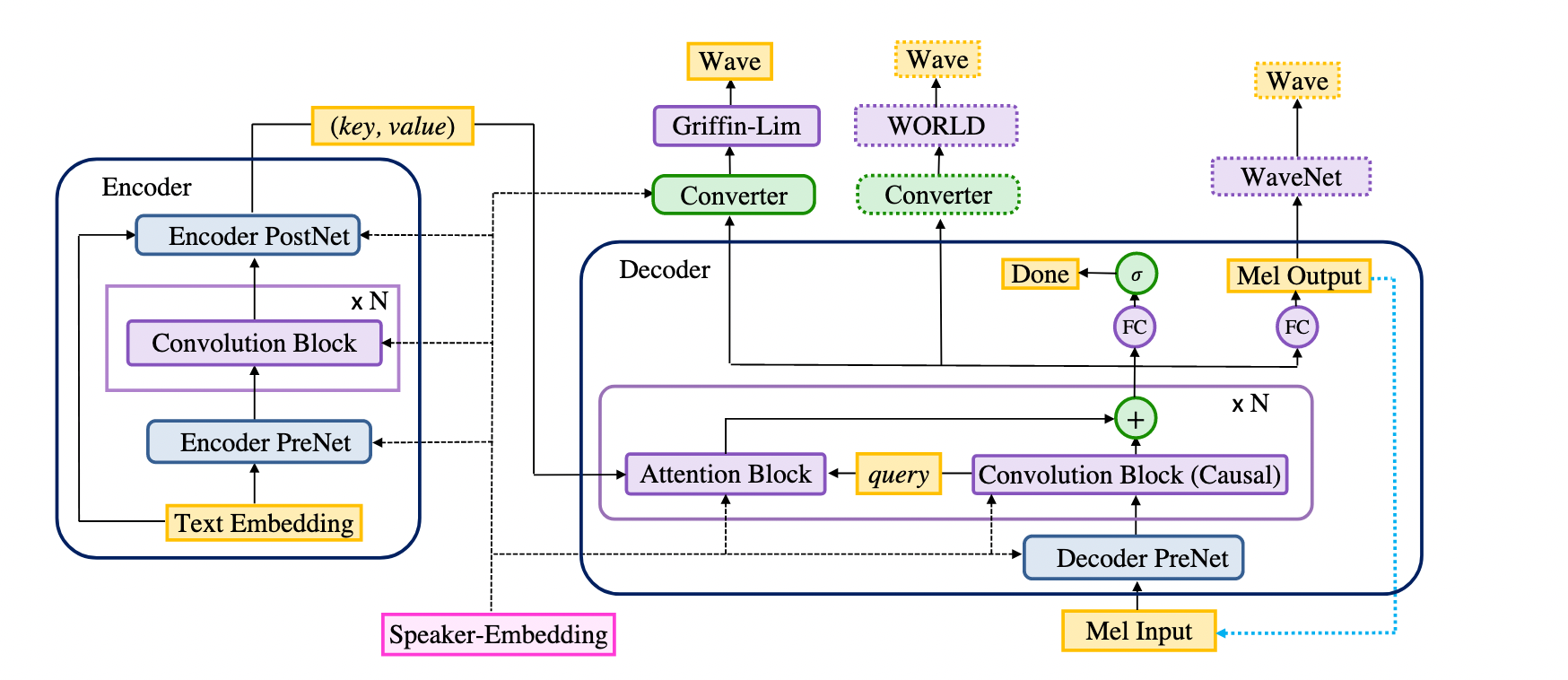|
|
||
|---|---|---|
| .. | ||
| configs | ||
| images | ||
| README.md | ||
| data.py | ||
| sentences.txt | ||
| synthesis.py | ||
| train.py | ||
| utils.py | ||
README.md
Deep Voice 3
PaddlePaddle dynamic graph implementation of Deep Voice 3, a convolutional network based text-to-speech generative model. The implementation is based on Deep Voice 3: Scaling Text-to-Speech with Convolutional Sequence Learning.
We implement Deep Voice 3 using Paddle Fluid with dynamic graph, which is convenient for building flexible network architectures.
Dataset
We experiment with the LJSpeech dataset. Download and unzip LJSpeech.
wget https://data.keithito.com/data/speech/LJSpeech-1.1.tar.bz2
tar xjvf LJSpeech-1.1.tar.bz2
Model Architecture
The model consists of an encoder, a decoder and a converter (and a speaker embedding for multispeaker models). The encoder and the decoder together form the seq2seq part of the model, and the converter forms the postnet part.
Project Structure
├── data.py data_processing
├── configs/ (example) configuration files
├── sentences.txt sample sentences
├── synthesis.py script to synthesize waveform from text
├── train.py script to train a model
└── utils.py utility functions
Saving & Loading
train.py and synthesis.py have 3 arguments in common, --checkpooint, iteration and output.
outputis the directory for saving results. During training, checkpoints are saved incheckpoints/inoutputand tensorboard log is save inlog/inoutput. Other possible outputs are saved instates/inoutuput. During synthesizing, audio files and other possible outputs are save insynthesis/inoutput. So after training and synthesizing with the same output directory, the file structure of the output directory looks like this.
├── checkpoints/ # checkpoint directory (including *.pdparams, *.pdopt and a text file `checkpoint` that records the latest checkpoint)
├── states/ # audio files generated at validation and other possible outputs
├── log/ # tensorboard log
└── synthesis/ # synthesized audio files and other possible outputs
--checkpointand--iterationfor loading from existing checkpoint. Loading existing checkpoiont follows the following rule: If--checkpointis provided, the checkpoint specified by--checkpointis loaded. If--checkpointis not provided, we try to load the model specified by--iterationfrom the checkpoint directory. If--iterationis not provided, we try to load the latested checkpoint from checkpoint directory.
Train
Train the model using train.py, follow the usage displayed by python train.py --help.
usage: train.py [-h] [--config CONFIG] [--data DATA] [--device DEVICE]
[--checkpoint CHECKPOINT | --iteration ITERATION]
output
Train a Deep Voice 3 model with LJSpeech dataset.
positional arguments:
output path to save results
optional arguments:
-h, --help show this help message and exit
--config CONFIG experimrnt config
--data DATA The path of the LJSpeech dataset.
--device DEVICE device to use
--checkpoint CHECKPOINT checkpoint to resume from.
--iteration ITERATION the iteration of the checkpoint to load from output directory
--configis the configuration file to use. The providedljspeech.yamlcan be used directly. And you can change some values in the configuration file and train the model with a different config.--datais the path of the LJSpeech dataset, the extracted folder from the downloaded archive (the folder which contains metadata.txt).--deviceis the device (gpu id) to use for training.-1means CPU.--checkpointis the path of the checkpoint.--iterationis the iteration of the checkpoint to load from output directory. See Saving-&-Loading for details of checkpoint loading.outputis the directory to save results, all results are saved in this directory. The structure of the output directory is shown below.
├── checkpoints # checkpoint
├── log # tensorboard log
└── states # train and evaluation results
├── alignments # attention
├── lin_spec # linear spectrogram
├── mel_spec # mel spectrogram
└── waveform # waveform (.wav files)
Example script:
python train.py \
--config=configs/ljspeech.yaml \
--data=./LJSpeech-1.1/ \
--device=0 \
experiment
You can monitor training log via tensorboard, using the script below.
cd experiment/log
tensorboard --logdir=.
Synthesis
usage: synthesis.py [-h] [--config CONFIG] [--device DEVICE]
[--checkpoint CHECKPOINT | --iteration ITERATION]
text output
Synthsize waveform with a checkpoint.
positional arguments:
text text file to synthesize
output path to save synthesized audio
optional arguments:
-h, --help show this help message and exit
--config CONFIG experiment config
--device DEVICE device to use
--checkpoint CHECKPOINT checkpoint to resume from
--iteration ITERATION the iteration of the checkpoint to load from output directory
-
--configis the configuration file to use. You should use the same configuration with which you train you model. -
--deviceis the device (gpu id) to use for training.-1means CPU. -
--checkpointis the path of the checkpoint. -
--iterationis the iteration of the checkpoint to load from output directory. See Saving-&-Loading for details of checkpoint loading. -
textis the text file to synthesize. -
outputis the directory to save results. The generated audio files (*.wav) and attention plots (*.png) for are save insynthesis/in ouput directory.
Example script:
python synthesis.py \
--config=configs/ljspeech.yaml \
--device=0 \
--checkpoint="experiment/checkpoints/model_step_005000000" \
sentences.txt experiment
or
python synthesis.py \
--config=configs/ljspeech.yaml \
--device=0 \
--iteration=005000000 \
sentences.txt experiment
